corn snake feeding guide
Corn snakes are popular, gentle, and colorful pets, known for their calm temperament and hardy nature, making them an excellent choice for both beginners and experienced snake enthusiasts.
1.1 Why Corn Snakes are Popular Pets
Corn snakes are popular pets due to their calm temperament, attractive patterns, and manageable size. They are easy to handle and tolerate human interaction well. Native to North America, they adapt readily to captivity and are relatively low-maintenance. Their docile nature makes them ideal for both experienced and novice snake owners. This, combined with their vibrant color morphs, has made them a favorite among reptile enthusiasts worldwide.
1.2 Basic Characteristics of Corn Snakes
Corn snakes (Elaphe guttata) are non-venomous, medium-sized snakes native to North America. They are known for their slender build, docile nature, and striking patterns. Adults typically grow to 3–5 feet in length, with males being slightly smaller than females. Corn snakes are excellent climbers and often exhibit a calm demeanor, making them a popular choice for pet ownership. Their color morphs vary widely, adding to their appeal.
Understanding Corn Snake Dietary Needs
Corn snakes are carnivorous, primarily consuming small mammals like mice and rats. Their diet requires a balance of protein, vitamins, and minerals to ensure optimal health and growth.
2.1 Overview of Corn Snake Feeding Requirements
Corn snakes are carnivorous, requiring a diet rich in protein from small mammals. Hatchlings need frequent feeding, while adults eat less often. Prey size should match the snake’s age and girth. Proper hydration is essential, with water always available. A balanced diet ensures growth, energy, and long-term health, avoiding nutritional deficiencies and promoting a thriving pet corn snake.
2.2 Importance of a Balanced Diet for Corn Snakes
A balanced diet is crucial for corn snakes to prevent metabolic issues and ensure proper growth. Protein-rich prey supports muscle development, while calcium and phosphorus maintain strong bones. A lack of essential nutrients can lead to health problems like metabolic bone disease or respiratory issues. A well-balanced diet promotes vitality, prevents deficiencies, and supports long-term health and immune function in corn snakes.
Corn Snake Feeding Chart
A corn snake feeding chart outlines feeding schedules based on age, size, and prey type, ensuring proper growth and health through consistent, balanced nutrition.
3.1 Feeding Schedule by Age and Size
Hatchling corn snakes typically eat every 5-7 days, while juveniles eat every 7-10 days. Adults usually eat every 10-14 days. The schedule aligns with growth stages, ensuring proper digestion and energy balance. Feeding frequency adjusts as snakes grow, with larger snakes needing less frequent meals. Consistency is key to maintaining optimal health and preventing overfeeding or underfeeding.
3.2 Recommended Prey Size and Type
Corn snakes thrive on prey proportional to their body size. Hatchlings start with small items like hopper mice or fuzzy mice. Juveniles graduate to larger mice or small rats. Adults typically eat adult mice or rats, depending on their size. Prey should match the snake’s girth at its widest point. Offering a variety ensures nutritional diversity and prevents dietary deficiencies. Avoid wild prey to minimize health risks.
Prey Size Guidelines
Corn snakes require prey proportional to their body size for optimal health. Properly sized prey prevents feeding complications and ensures efficient digestion, supporting overall well-being.
4.1 Determining the Right Prey Size for Your Corn Snake
Choosing the correct prey size for your corn snake is crucial for proper digestion and growth. Prey should be no wider than the snake’s widest point and approximately 1.5 times the snake’s midbody diameter. For hatchlings, small mice or hopper mice are ideal, while adults can handle larger mice or rats. Always avoid prey that could cause discomfort or health issues.
4.2 Avoiding Common Mistakes in Prey Size Selection
Common mistakes in prey size selection include offering prey that is too large or too small. Oversized prey can cause regurgitation or impaction, leading to serious health issues. Undersized prey may result in malnutrition, as the snake may not receive adequate nutrients; Always ensure prey is appropriately sized for your corn snake’s age and size to maintain optimal health and digestion. Monitor your snake’s growth and adjust prey size accordingly.
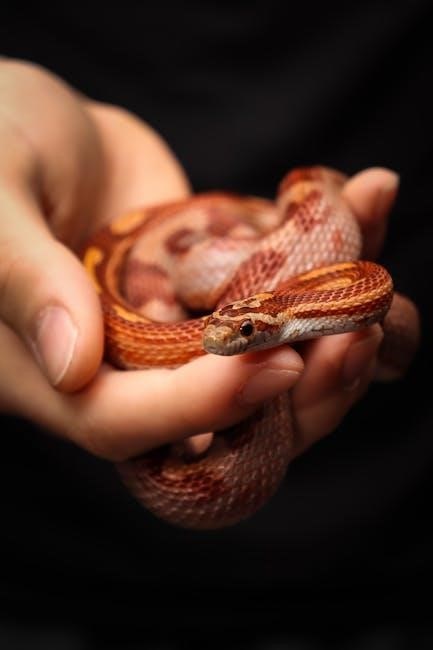
Feeding Methods
Popular feeding methods include tong feeding and offering live or frozen-thawed prey. Tong feeding allows for controlled feeding, reducing stress and ensuring the snake eats safely. Live prey can stimulate natural hunting behavior but requires careful monitoring to avoid injuries. Choose the method that best suits your snake’s preferences and your comfort level as a handler.
5.1 Tong Feeding: Benefits and Tips
Tong feeding is a stress-free method for both snakes and handlers. It allows precise control over feeding and reduces the risk of injury from live prey. Benefits include minimizing stress and ensuring the snake eats fully. Tips: Use tongs that match prey size, move naturally, and offer prey gently. Avoid sudden movements to prevent startling the snake. Clean tongs after use to maintain hygiene and prevent bacterial growth.
5.2 Live vs. Frozen-Thawed Prey: Pros and Cons
Live prey stimulates natural hunting behavior and may be more appealing to some corn snakes. However, it poses risks like injury from prey bites. Frozen-thawed prey is safer, easier to store, and reduces disease risks but may require scenting to entice eating. Choose based on the snake’s preference and your convenience, ensuring a balanced diet either way for optimal health.
Feeding Live vs. Frozen Prey
Live prey mimics natural hunting, while frozen-thawed is convenient and reduces disease risks. Choose based on snake preference, safety, and dietary needs for optimal health outcomes. Always prioritize freshness and proper preparation to ensure a balanced and nutritious diet tailored to your corn snake’s specific requirements and well-being.
6.1 Advantages of Feeding Frozen-Thawed Prey
Feeding frozen-thawed prey offers convenience, reduced parasite risks, and consistent quality. It minimizes the stress of live prey and ensures nutrient-rich meals. Easier to store, frozen prey also allows for precise portion control, promoting healthy digestion and preventing overfeeding. This method is widely recommended for its safety and reliability in maintaining optimal corn snake health and well-being.
6.2 When to Consider Feeding Live Prey
Live prey is ideal for picky eaters or snakes refusing frozen options. It stimulates natural hunting behavior, ensuring meal engagement. Use live prey for underweight snakes or during breeding seasons to boost appetite. However, it requires careful monitoring to prevent injuries and stress. Live feeding should be a last resort, as frozen-thawed prey is generally safer and more convenient for corn snakes.
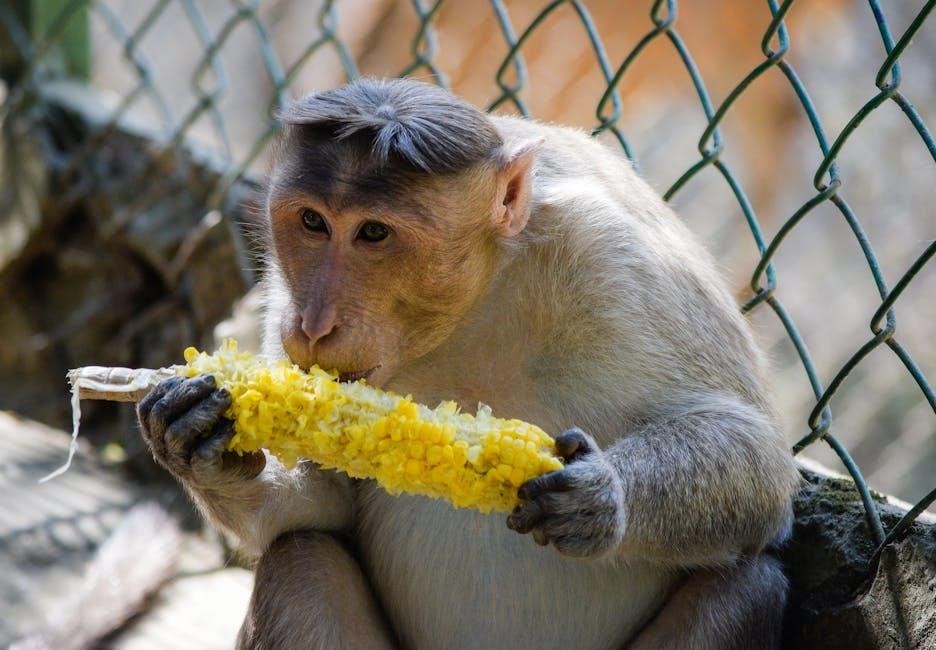
Feeding Frequency and Schedule
Corn snakes’ feeding frequency varies with age. Hatchlings eat weekly, juveniles every 7-10 days, and adults every 10-14 days. Adjust based on growth and activity levels.
7.1 Hatchling and Juvenile Feeding Schedule
Hatchlings typically eat every 7-10 days, starting with small prey items like pinkie mice. As they grow, juvenile corn snakes transition to larger prey and a slightly extended feeding schedule. By around 6 months, juveniles usually eat every 10-14 days. Consistency is key to support healthy growth and development during these early life stages.
7.2 Adult Corn Snake Feeding Frequency
Adult corn snakes typically eat every 14 to 21 days, depending on their size and activity level. They thrive on a consistent feeding schedule, with prey items such as adult mice or small rats. This frequency allows proper digestion and maintains a healthy weight. Adjustments may be needed based on the snake’s growth or metabolism, ensuring optimal long-term health.
Prey Variety for Corn Snakes
Offering diverse prey like mice, rats, rabbits, and quail ensures a balanced diet and prevents picky eating, promoting optimal health and feeding enthusiasm in corn snakes.
8.1 Common Prey Items for Corn Snakes
Corn snakes primarily feed on small mammals, with mice and rats being the most common prey items due to their availability and nutritional value. Hatchlings often start with pinkie or fuzzy mice, while juveniles and adults can consume hopper mice or small rats. Rabbits and quail are occasionally offered as larger, less frequent meals to provide variety and meet dietary needs.
8.2 Introducing Variety in the Diet
Providing a varied diet is essential for maintaining a corn snake’s overall health and preventing boredom. While mice and rats are staples, introducing occasional prey like quail, gerbil, or rabbit can offer diverse nutrients. This variety helps ensure a broad nutrient profile and mimics natural feeding behavior. Rotate prey types every few feedings to keep the diet balanced and engaging for your pet corn snake.
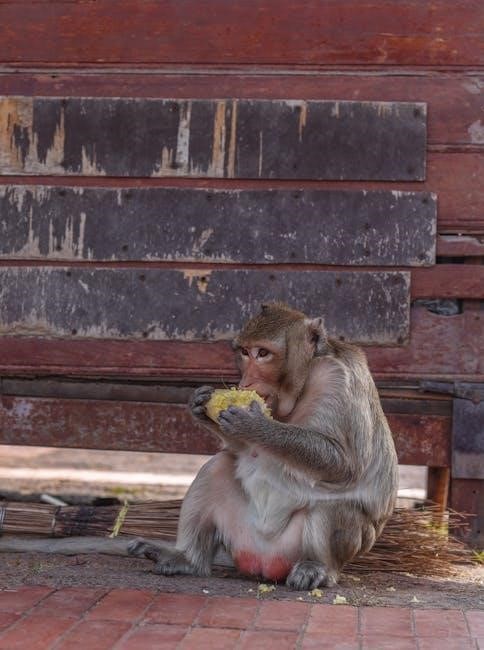
Nutritional Considerations
Proper nutrition is vital for a corn snake’s growth and health. A balanced diet ensures adequate protein, fats, vitamins, and minerals, promoting energy and well-being. Prey items naturally provide these nutrients, maintaining the snake’s overall condition and digestive health.
9.1 Importance of Vitamin A and D in Corn Snake Diet
Vitamin A is essential for corn snakes’ vision, immune function, and skin health, while vitamin D aids in calcium absorption and bone development. Deficiencies can lead to health issues like respiratory problems or metabolic bone disease. Providing prey items rich in these vitamins ensures optimal health. Frozen-thawed prey often contains adequate levels, but supplements may be needed in some cases to prevent deficiencies and promote overall well-being.
9.2 Role of Calcium and Phosphorus for Bone Health
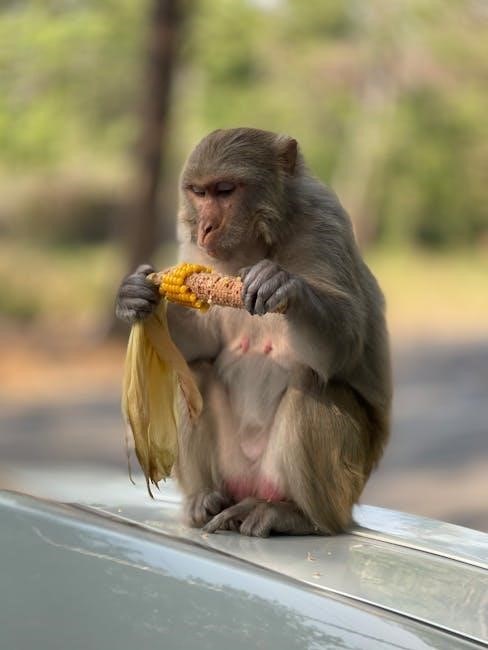
Calcium and phosphorus are critical for corn snakes’ skeletal development and bone density. Calcium supports proper bone formation, while phosphorus aids in mineralization. A balanced ratio of these minerals prevents metabolic bone disease. Prey items naturally provide these nutrients, but occasional supplementation may be necessary to ensure optimal bone health and prevent developmental issues in young snakes.
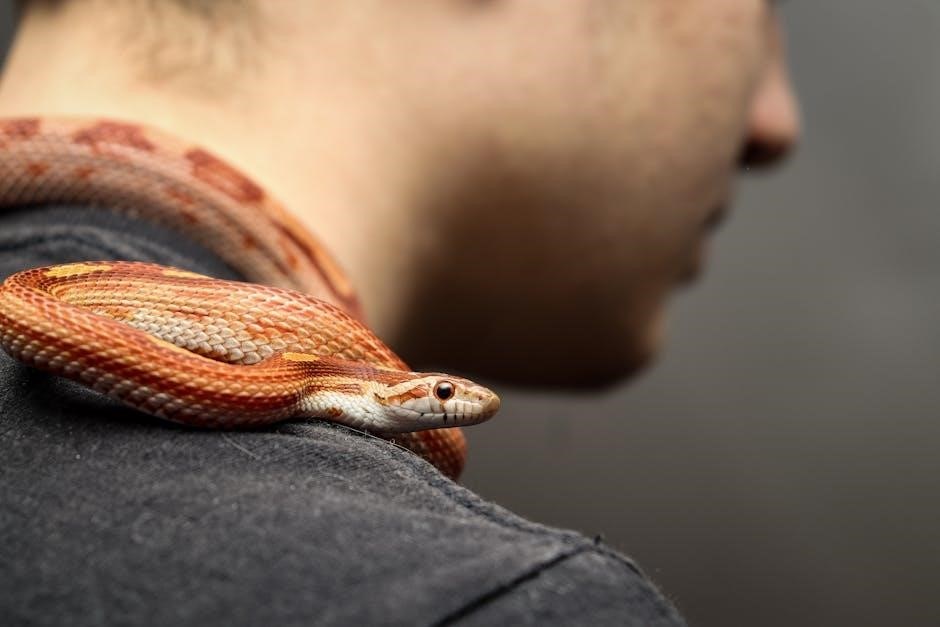
Common Feeding Challenges
Corn snakes may face feeding challenges like picky eating, overeating, or refusal to eat due to environmental factors or prey presentation issues. Addressing these promptly ensures healthy growth.
10.1 Dealing with Picky Eaters
Picky eating in corn snakes can arise from prey type, size, or presentation. Offer variety, such as mice or rats, and use tong feeding to stimulate their natural hunting instinct. Ensure proper temperature gradients, as this can affect appetite. If issues persist, consult a veterinarian to rule out underlying health concerns. Patience and consistency are key to resolving feeding hesitancy in picky corn snakes.
10.2 Managing Overeating or Undereating
Monitor your corn snake’s feeding habits to prevent overeating or undereating. Adjust prey size and frequency based on growth and activity levels. Avoid offering prey that is too large, as it can lead to overeating. Track weight and body condition regularly. Undereating may require smaller, more frequent meals. Consult a veterinarian if feeding issues persist to ensure optimal health and proper growth patterns in your corn snake.
Monitoring and Adjusting Feeding
Regularly observe your corn snake’s growth, behavior, and body condition. Adjust feeding schedules and prey sizes based on these observations to promote healthy development and prevent issues.
11.1 Signs of a Well-Fed Corn Snake
A well-fed corn snake exhibits smooth shedding, shiny scales, and a rounded, muscular appearance. It should maintain a healthy weight, show steady growth, and display alert behavior. Ensure regular droppings are solid and well-formed, indicating proper digestion. Avoid visible ribs or a overly bloated midsection, as these signal underfeeding or overfeeding. A clean, active snake with a robust appetite is a sign of successful feeding practices.
11.2 Adjustments Based on Snake’s Body Condition
Monitor your corn snake’s body condition to guide feeding adjustments. If the snake appears underweight, increase feeding frequency or prey size. For overweight snakes, reduce feeding frequency or offer smaller prey. Adjustments should align with growth stages and activity levels, ensuring a balanced weight and overall health. Gradual changes help prevent stress and promote long-term well-being.
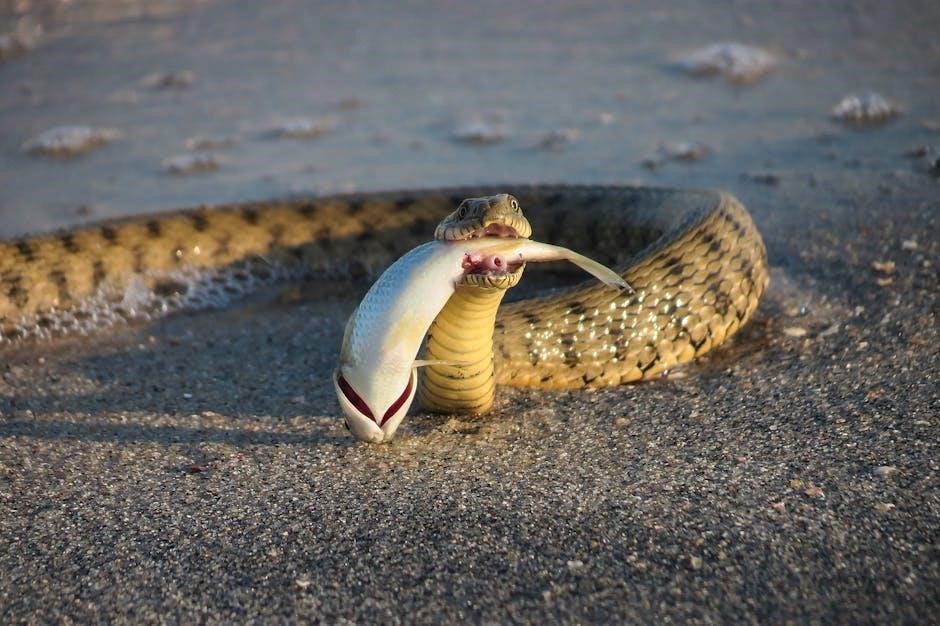
Feeding Tips for Different Life Stages
Adjust feeding strategies based on age and size. Hatchlings need smaller, frequent meals, while adults require larger prey less often. Monitor transitions and supervision closely.
12.1 Feeding Hatchlings: Special Considerations
Hatchlings require small, frequent meals to support rapid growth. Offer prey items like pinkie mice, ensuring they are no wider than the snake’s head. Feed every 2-3 days, as their metabolism is high. Provide a shallow water dish for hydration. Monitor feeding closely to avoid overfeeding, as hatchlings can be prone to regurgitation if fed too much or too quickly.
12.2 Feeding Juveniles: Transitioning to Adult Diets
Juveniles should transition to larger prey as they grow. Begin introducing hopper mice or small rats, slightly larger than their current meals. Feed every 5-7 days, allowing proper digestion. Maintain variety by alternating prey types to ensure a balanced diet. Monitor growth and adjust prey size gradually to prevent overfeeding. This stage prepares them for adult feeding schedules and prey sizes.
12.3 Feeding Adult Corn Snakes: Long-Term Health
Adult corn snakes thrive on a consistent feeding schedule, typically every 7-10 days. Offer prey items like rats or mice, matching their size to the snake’s girth. Maintain variety to ensure balanced nutrition. Avoid overfeeding to prevent obesity. Provide fresh water always. A steady, appropriate diet supports long-term health and vitality in adult corn snakes.
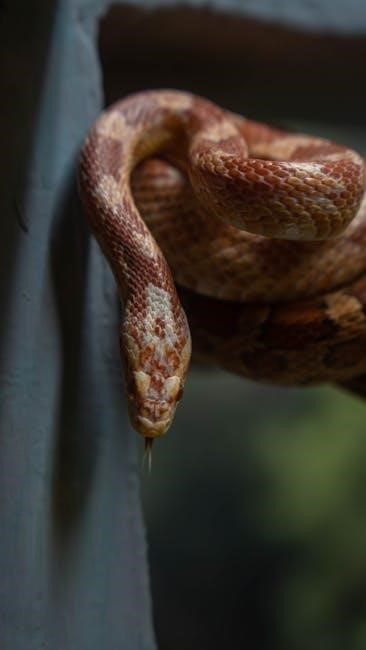
Recognizing Signs of Malnutrition or Obesity
Monitor for malnutrition signs like weight loss, dull color, or reduced activity. Obesity may show as a swollen midsection or lethargy. Both can harm health.
13.1 Physical Symptoms of Malnutrition
Malnutrition in corn snakes can lead to visible weight loss, dull coloration, and reduced activity levels. The snake may appear thin, with prominent ribs and a narrow midsection. Shedding difficulties and poor appetite are also common indicators. If left unaddressed, malnutrition can weaken the immune system and impair overall health, making prompt intervention essential.
13.2 Identifying and Addressing Obesity in Corn Snakes
Obesity in corn snakes is marked by an unusually bulky appearance, with visible fat deposits near the tail and midsection. Movement may become sluggish, and shedding can be challenging. To address this, reduce feeding frequency and portion sizes. Introduce exercise by providing a larger enclosure or encouraging exploration. Consult a veterinarian for guidance to ensure a healthy weight is achieved safely.
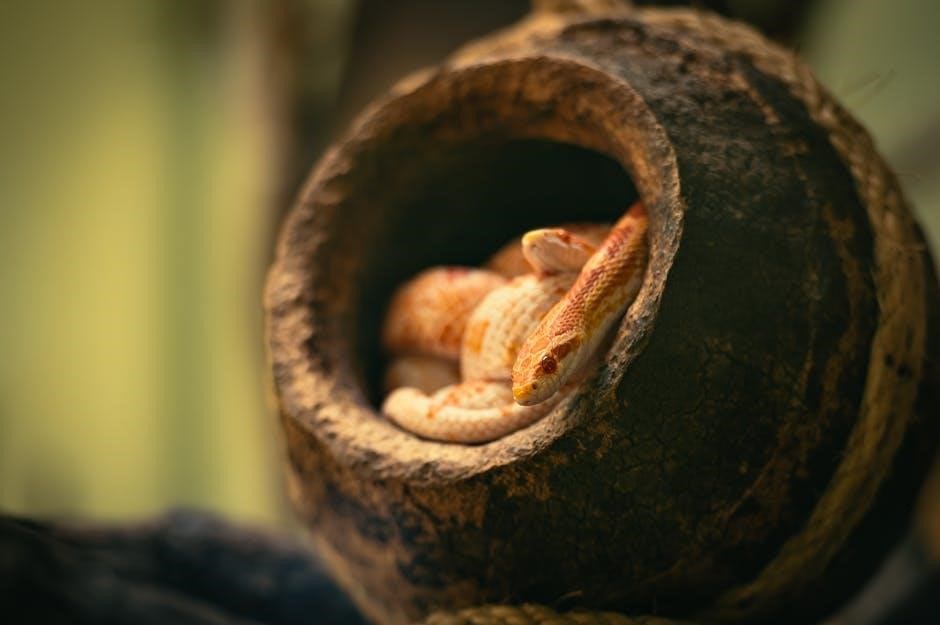
Remedies for Feeding Issues
Remedies for feeding issues often involve adjusting feeding schedules, prey variety, and environmental conditions. Consult a veterinarian to address persistent problems and ensure your snake’s optimal health.
14.1 Correcting Underfeeding or Overfeeding
To correct underfeeding, increase prey size or feeding frequency. For overfeeding, reduce portion sizes or extend the time between meals. Monitor weight and adjust accordingly to maintain a healthy, balanced growth rate. Ensure proper hydration and consult a vet if issues persist to rule out underlying health concerns.
14.2 Supplements: When and How to Use Them
Supplements like calcium and vitamin D3 are essential for bone health. Use a calcium powder 2-3 times a month and a multivitamin with D3 monthly. Avoid over-supplementation, as it can harm your snake. Dust prey items lightly, focusing on live prey for natural nutrient intake. Consult a vet before adding supplements to ensure proper balance and prevent metabolic bone disease;
Role of Water in Feeding
Water is essential for hydration and digestion. Keep a clean water bowl in the enclosure to maintain humidity and aid in swallowing prey, ensuring proper feeding.
15.1 Importance of Water for Digestion
Water plays a crucial role in corn snake digestion, aiding the breakdown and absorption of nutrients from prey. Hydration ensures proper mobility of food through the digestive tract, preventing impaction. A clean water source helps maintain humidity, promoting healthy shedding and overall bodily functions. Dehydration can lead to digestive issues, making consistent water availability vital for optimal health and feeding efficiency in corn snakes.
15.2 Best Practices for Water Placement in Enclosures
Place water bowls in accessible, shallow dishes to prevent tipping and ensure easy access. Position them away from heat sources to maintain water temperature and humidity levels. Keep water clean by changing it daily to prevent bacterial growth. Avoid placing water near feeding areas to minimize contamination risk. Ensure the enclosure’s water placement promotes a clean, healthy environment for your corn snake.
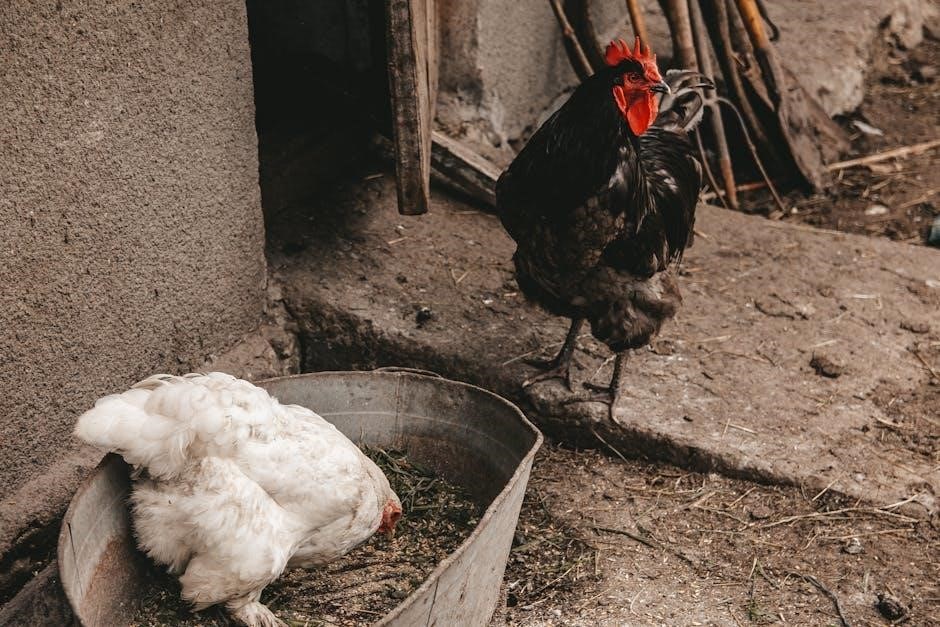
Feeding Tools and Accessories
Essential tools include tongs for safe feeding and feeding tweezers for precise prey placement. Accessories like escape-proof water bowls and feeding mats help maintain hygiene and organization.
16.1 Essential Feeding Tools for Corn Snakes
Sturdy feeding tongs or forceps are crucial for safely offering prey without risking bites. A digital scale helps measure prey size accurately, ensuring proper portion control. Feeding tweezers or small tongs are ideal for hatchlings or precise feeding. These tools prevent stress and injury, making feeding efficient and stress-free for both the snake and handler.
16.2 Recommended Feeding Accessories
Feeding accessories like hiding places or feeding hides help reduce stress during meals. A feeding dish prevents prey from touching the substrate, minimizing the risk of impaction. A temperature gradient ensures proper digestion, while a water bowl nearby keeps your snake hydrated. A hygrometer maintains optimal humidity, promoting healthy digestion and overall well-being.
A well-structured feeding plan and proper care are essential for your corn snake’s health. Consistency in feeding schedules ensures optimal digestion and growth. Always observe your snake’s behavior and adjust accordingly. Be patient and adaptable, as every snake is unique. With dedication and the right techniques, your corn snake will thrive. Happy feeding!